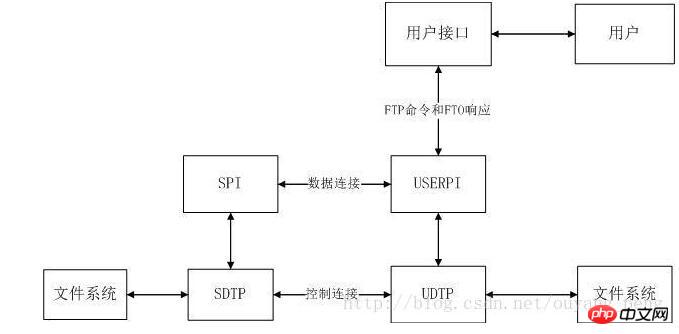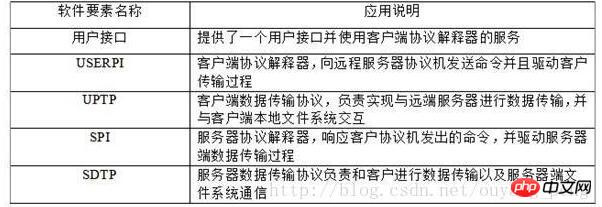 Java
Java
 javaTutorial
javaTutorial
 Simple FTP software implemented in Java language - Detailed explanation of FTP protocol (1)
Simple FTP software implemented in Java language - Detailed explanation of FTP protocol (1)
Simple FTP software implemented in Java language - Detailed explanation of FTP protocol (1)
This article mainly introduces the first article of implementing simple FTP software in Java language. It analyzes the FTP protocol and has certain reference value. Interested friends can refer to it
FTP(File Transfer Protocol) is the file transfer protocol. Copying files from a remote FTP server to a local computer through an FTP client is called downloading, and copying files from a local computer to a remote FTP server is called upload. Uploading and downloading are the two most commonly used functions of FTP. Function. FTP uses the TCP protocol at the transport layer for transmission, so the connection between the client and the server is reliable and connection-oriented, providing reliable guarantee for data transmission. The goals of FTP are as follows:
Improve file sharing
Provide indirect remote control of computers
Avoid user changes caused by differences in file storage systems between hosts
Provide reliability and efficiency for data transmission
FTP protocolModelAs shown in the figure below

FTP usage TCP service requires two connections. One is a data connection used for data transmission, generally using port 21, and the other is a control connection used to transmit control information (commands and responses), generally using port 20. What a control connection needs to transmit is only control information, such as a line of command or a line of response code, while a data connection needs to transmit a variety of data types, such as text files, graphic files, applications, etc.
The interactive elements used in the FTP protocol model include user
, USERPI, UPTP, SPI, and SDTP. The description is shown in the figure below

There are two ways to transfer FTP: text transfer mode and binary data transfer mode. The text mode is also called ASCII mode, and the binary mode is also called Binary mode.
FTP services are divided into two types: ordinary FTP and anonymous FTP services.
Commonly used FTP commands are:
1) Access command
USER: Specify Username
ABOR: Abnormal interruption of data connection program
QUIT: Log out from the system
REIN: Reinitialize
2) File management command
CWD: Change the working directory on the server to the specified directory
DELE: Request
to delete a file on the
server. LIST: List subdirectories or files MKD: Request to create a new directory on the server
PWD: Display the current working directory
RMD: Delete the specified directory from the server
3) Data format command
#TYPE: Define the file type, there are four types, and there are four parameters: A, E , I and L correspond to ASCII, EBCDIC, IMAGB and LOCAL types respectively.
MODE: Define the transmission method
4) Port definition command
PASV: The server selects the port,
this port to send the active open PORT: The client selects the port, the server uses this port to create the active open
5) File transfer command
RETR:
, transfer the file from the server to the clientSTOR: store File, file is transferred from client to server STAT: Returns the
status of the file
ALLOO: Allocates storage space for the file on the server
HELP: Ask for server informationNOOP: Check whether the server is working
SYST : Query the operating system used by the server
After the client sends the FTP command, the server returns a response code. The response code is represented by a three-digit code:
The first digit
defines the status of the command.1 means the server received the information correctly but has not yet processed it.
2 means the server has processed the information correctly.
4 indicates that the information is temporarily incorrect.
5 means the information is permanently wrong.
The second number
0 indicates syntax. The third number provides more additional information.
1 represents system status and information.
2 indicates the connection status.
3 represents information related to user authentication.
4 means not specified.
5 represents information related to the file system.
The above is the detailed content of Simple FTP software implemented in Java language - Detailed explanation of FTP protocol (1). For more information, please follow other related articles on the PHP Chinese website!

Hot AI Tools

Undresser.AI Undress
AI-powered app for creating realistic nude photos

AI Clothes Remover
Online AI tool for removing clothes from photos.

Undress AI Tool
Undress images for free

Clothoff.io
AI clothes remover

Video Face Swap
Swap faces in any video effortlessly with our completely free AI face swap tool!

Hot Article

Hot Tools

Notepad++7.3.1
Easy-to-use and free code editor

SublimeText3 Chinese version
Chinese version, very easy to use

Zend Studio 13.0.1
Powerful PHP integrated development environment

Dreamweaver CS6
Visual web development tools

SublimeText3 Mac version
God-level code editing software (SublimeText3)

Hot Topics
 1389
1389
 52
52
 Perfect Number in Java
Aug 30, 2024 pm 04:28 PM
Perfect Number in Java
Aug 30, 2024 pm 04:28 PM
Guide to Perfect Number in Java. Here we discuss the Definition, How to check Perfect number in Java?, examples with code implementation.
 Weka in Java
Aug 30, 2024 pm 04:28 PM
Weka in Java
Aug 30, 2024 pm 04:28 PM
Guide to Weka in Java. Here we discuss the Introduction, how to use weka java, the type of platform, and advantages with examples.
 Smith Number in Java
Aug 30, 2024 pm 04:28 PM
Smith Number in Java
Aug 30, 2024 pm 04:28 PM
Guide to Smith Number in Java. Here we discuss the Definition, How to check smith number in Java? example with code implementation.
 Java Spring Interview Questions
Aug 30, 2024 pm 04:29 PM
Java Spring Interview Questions
Aug 30, 2024 pm 04:29 PM
In this article, we have kept the most asked Java Spring Interview Questions with their detailed answers. So that you can crack the interview.
 Break or return from Java 8 stream forEach?
Feb 07, 2025 pm 12:09 PM
Break or return from Java 8 stream forEach?
Feb 07, 2025 pm 12:09 PM
Java 8 introduces the Stream API, providing a powerful and expressive way to process data collections. However, a common question when using Stream is: How to break or return from a forEach operation? Traditional loops allow for early interruption or return, but Stream's forEach method does not directly support this method. This article will explain the reasons and explore alternative methods for implementing premature termination in Stream processing systems. Further reading: Java Stream API improvements Understand Stream forEach The forEach method is a terminal operation that performs one operation on each element in the Stream. Its design intention is
 TimeStamp to Date in Java
Aug 30, 2024 pm 04:28 PM
TimeStamp to Date in Java
Aug 30, 2024 pm 04:28 PM
Guide to TimeStamp to Date in Java. Here we also discuss the introduction and how to convert timestamp to date in java along with examples.
 Java Program to Find the Volume of Capsule
Feb 07, 2025 am 11:37 AM
Java Program to Find the Volume of Capsule
Feb 07, 2025 am 11:37 AM
Capsules are three-dimensional geometric figures, composed of a cylinder and a hemisphere at both ends. The volume of the capsule can be calculated by adding the volume of the cylinder and the volume of the hemisphere at both ends. This tutorial will discuss how to calculate the volume of a given capsule in Java using different methods. Capsule volume formula The formula for capsule volume is as follows: Capsule volume = Cylindrical volume Volume Two hemisphere volume in, r: The radius of the hemisphere. h: The height of the cylinder (excluding the hemisphere). Example 1 enter Radius = 5 units Height = 10 units Output Volume = 1570.8 cubic units explain Calculate volume using formula: Volume = π × r2 × h (4
 Create the Future: Java Programming for Absolute Beginners
Oct 13, 2024 pm 01:32 PM
Create the Future: Java Programming for Absolute Beginners
Oct 13, 2024 pm 01:32 PM
Java is a popular programming language that can be learned by both beginners and experienced developers. This tutorial starts with basic concepts and progresses through advanced topics. After installing the Java Development Kit, you can practice programming by creating a simple "Hello, World!" program. After you understand the code, use the command prompt to compile and run the program, and "Hello, World!" will be output on the console. Learning Java starts your programming journey, and as your mastery deepens, you can create more complex applications.



